The ASRock DeskMini A300 Review: An Affordable DIY AMD Ryzen mini-PC
by Ganesh T S on April 26, 2019 8:00 AM ESTGPU Performance for Workstation Workloads - SPECviewperf 13
The SPECviewperf benchmark from SPEC provides an idea of the capabilities of the GPU in a workstation from the perspective of different CAD, content creation, and visual data analysis tools. It makes more sense to process these benchmarks on workstations with professional GPUs, but, consumer GPUs are often the choice for machines that need to handle both gaming and professional workloads. Since the Radeon RX Vega 11 performs admirably for an integrated GPU in our gaming tests, we wanted to give the DeskMini A300 a go with the SPECviewperf 13 workloads also.
SPECviewperf 13 includes nine different workloads representative of graphics content and behavior of actual applications. They make use of the OpenGL 4.0 and DirectX 12 APIs under Windows. SPECviewperf 13's workloads (termed viewsets) can officially be run only at two desktop resolutions (1920 x 1080, and 3840 x 2160), and need the display scaling to be set to 100% (DPI of 96). The available viewsets are listed below.
- 3ds Max (3dsmax-06)
- CATIA (catia-05)
- Creo (creo-02)
- Energy (energy-02)
- Maya (maya-05)
- Medical (medical-02)
- Showcase (showcase-02)
- Siemens NX (snx-03)
- Solidworks (sw-04)
The 3ds Max and Showcase viewsets are available only when processing at 1920 x 1080. The rest are available at both resolutions.
We processed SPECviewperf 13 at both resolutions on the ASRock DeskMini A300. The benchmark measures the frame rate at which the GPU renders the scenes in a viewset. Each viewset is composed of different scenes and rendering modes, and the composite score for the viewset is a weighted geometric mean of the FPS measured for the different scenes. In this section, we take a look at how its composite scores stack up against other systems targeting this market segment.
3ds Max (3dsmax-06)
The 3dsmax-06 viewset comprises of 11 different scenes. They have been created from traces of the graphics workload generated by Autodesk 3ds Max 2016 using the default Nitrous DX11 driver. Additional details are available here.
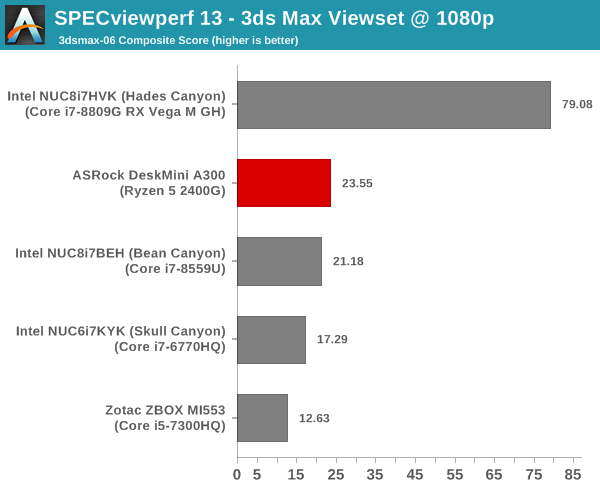
The DeskMini A300 is again the leading iGPU-only system, but, the Bean Canyon NUC's performance is quite close.
CATIA (catia-05)
The catia-05 viewset comprises of 14 different tests created from traces of the graphics workload generated by the CATIA V6 R2012 application from Dassault Systemes. Additional details are available here.
| SPECviewperf 13: CATIA Viewset Composite Scores | |||

The DeskMini A300 and the Bean Canyon NUC are essentially tied in this workload.
Creo (creo-02)
The creo-02 viewset comprises of 16 different tests created from traces of the graphics workload generated by the Creo 3 and Creo 4 applications from PTC. Additional details are available here.
| SPECviewperf 13: Creo Viewset Composite Scores | |||
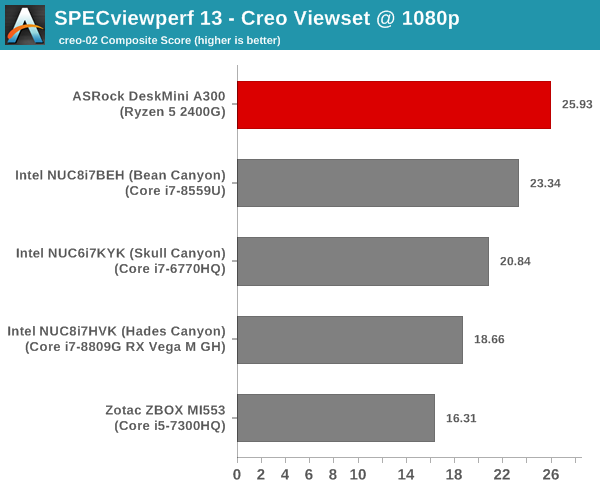
The Ryzen system is ahead at 1080p, but, falls slightly behind the Bean Canyon NUC at 2160p.
Energy (energy-02)
The energy-02 viewset comprises of 6 different tests based on techniques used by the OpendTect seismic visualization application. Additional details are available here.
| SPECviewperf 13: Energy Viewset Composite Scores | |
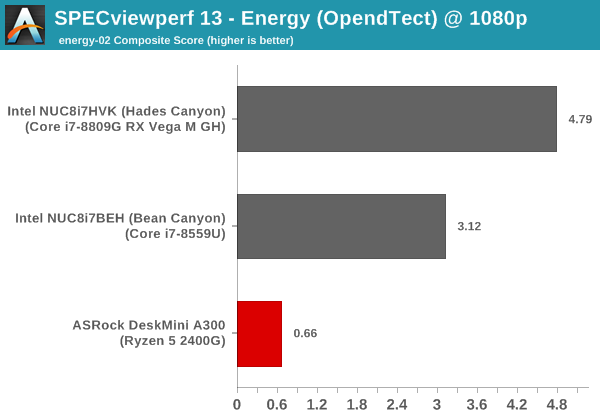
The energy-02 workload is a tough nut to crack for SFF systems, and the DeskMini A300 seems to have some trouble in completing the workload properly. At 2160p, all the systems that we are comparing the A300 against had trouble with the workload - hence, we do not have a graph for the workload at that resolution.
Maya (maya-05)
The maya-05 viewset comprises of 10 different tests based on traces of the graphics workload generated by Autodesk Maya 2017. Additional details are available here.
| SPECviewperf 13: Maya Viewset Composite Scores | |||
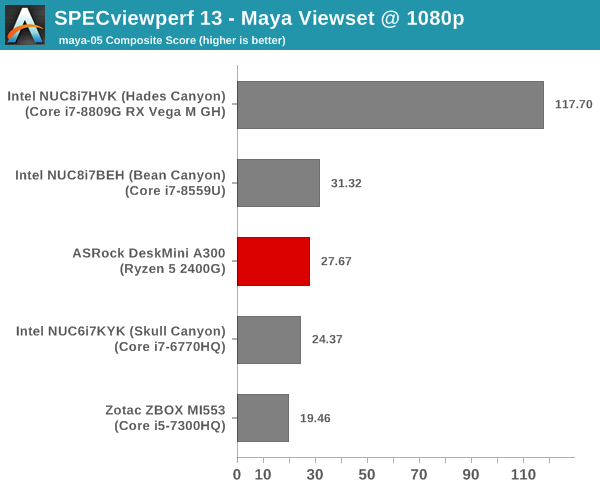
The Bean Canyon NUC edges ahead of the DeskMini A300 for the maya-05 workload at both resolutions.
Medical (medical-02)
The medical-02 viewset comprises of 8 different tests derived from 4 distinct datasets. Each test uses the ImageVis3D volume visualization program's Tuvok rendering core for 2D projections of 3D volumetric grids. Additional details are available here.
| SPECviewperf 13: Medical Viewset Composite Scores | |||
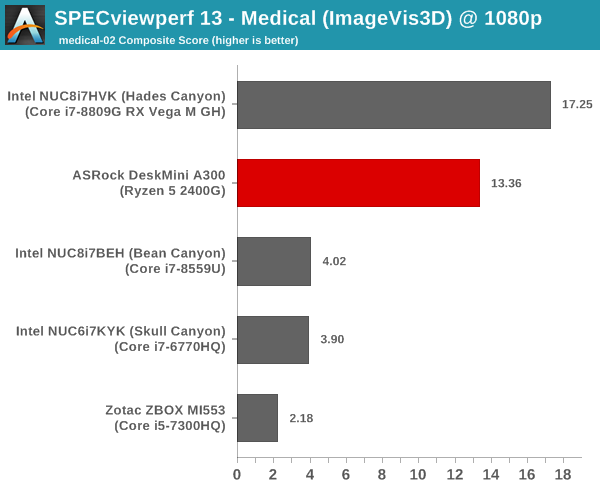
The medical-02 viewset represents a clear victory for the DeskMini A300 over other iGPU-only systems.
Showcase (showcase-02)
The showcase-02 viewset comprises of 4 tests created from traces of the Autodesk Showcase 2013 application rendering a racecar model with 8 million vertices using different modes. Additional details are available here.
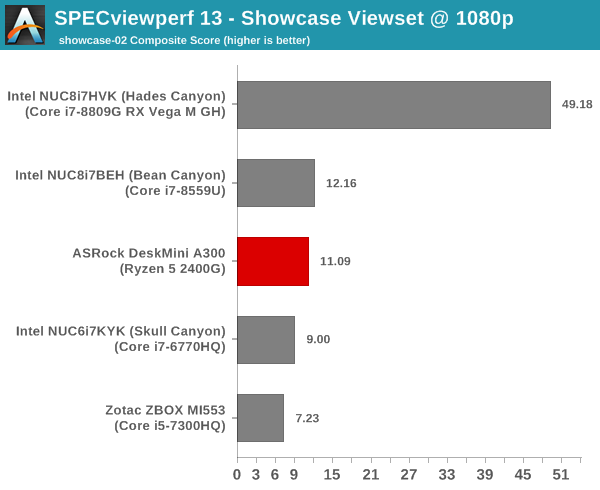
The showcase-02 viewset sees the Bean Canyon NUC edge slightly ahead of the DeskMini A300.
Siemens NX (snx-03)
The snx-03 viewset comprises of 10 tests created with traces from the graphics workload generated by the NX 8.0 application from Siemens PLM. Additional details are available here.
| SPECviewperf 13: Siemens NX Viewset Composite Scores | |||
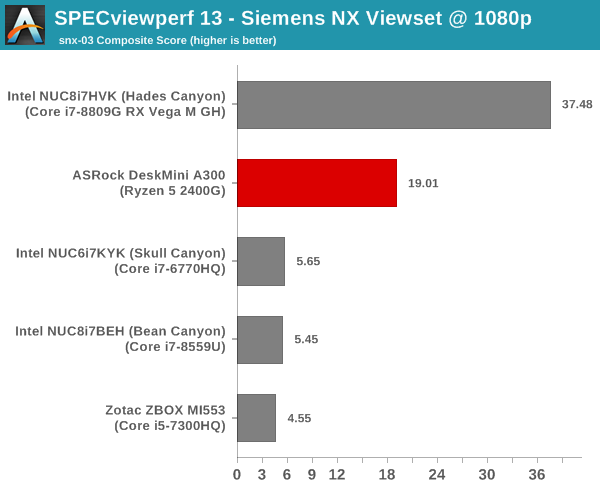
The snx-03 viewset is similar to the medical-02 viewset in terms of the DeskMini A300 enjoying a clear lead.
Solidworks (sw-04)
The sw-04 viewset comprises of 11 tests created from traces of Dassault Systemes’ SolidWorks 2013 SP1 application. Additional details are available here.
| SPECviewperf 13: Solidworks Viewset Composite Scores | |||
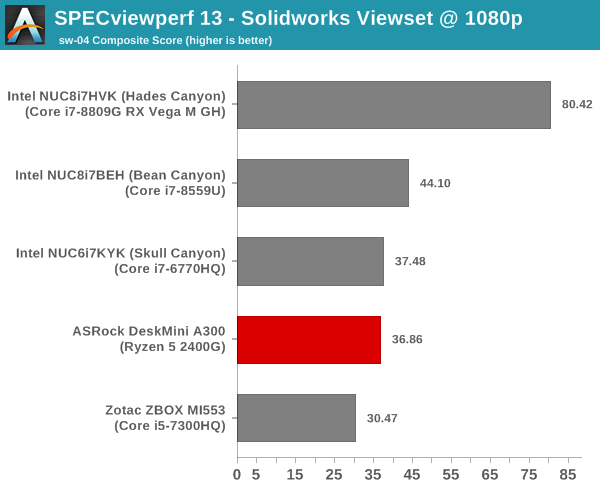
In this viewset, we see the Bean Canyon NUC come out on top, with the DeskMini A300 tussling it out with the Skull Canyon NUC for the second place amongst the iGPU-only systems.
Overall, for the SPECviewperf 13 workloads, we see that the DeskMini A300 is not a clear winner. There are a couple of viewsets in which the A300 performs significantly better, but, for the most part, the Bean Canyon NUC mounts an excellent challenge. The reasons for this could be two-fold - on one hand, the Radeon drivers for the RX Vega 11 might not be really optimized for these kinds of workloads. On the other, the Bean Canyon NUC employs an Iris Plus 655 GPU which comes with 128MB of eDRAM cache. It is likely that the eDRAM is beneficial for SPECviewperf 13 workloads.










88 Comments
View All Comments
Haawser - Sunday, April 28, 2019 - link
@oliwek That's the 310, it's an Intel barebones system, not Ryzen.sor - Saturday, April 27, 2019 - link
If you sign up for Newegg notifications you’ll probably have one within a week. I got one of mine about three weeks ago and the other last week.yankeeDDL - Monday, April 29, 2019 - link
I'm just going to throw it as a suggestion.I understand the purpose and the rationale in comparing similarly priced models, and all relatively recent/available, however ... I think it would add an enormous value to "normal" users to be able to somewhat put things in perspective with slightly dated hardware.
I am not saying that we should be able to compare the Ryzen 5 2400G with an 80486, but, to give you an example, I have an A10-8700P and I have been considering an upgrade, but it seems really difficult to find a way to get an idea of just how much faster the 2400G is.
The A10-8700P is certainly not efficient, but it does have 4 cores, and a decent iGPU, already based on the GCN. There's no question that the 2400G will trounce it in efficiency, but is it a worth upgrade?
It is just an example, to indicate that having also 2-3 previous generations in the comparisons would not be such a bad idea, in my opinion. Just a thought.
Irata - Wednesday, May 1, 2019 - link
If you are looking for this type of comparison, planet3dnow de has one between an Athlon 5350 (Jaguar) vs Athlon 200GE. It's in German but maybe you can get useable results using Google translate.They also did a review of the Hewlett-Packard 17-ca1004ng notebook with a Ryzen 5 3500U comparing it to its Bristol Ridge predecessor.
Both show just how far AMD has come with Ryzen.
mikato - Tuesday, April 30, 2019 - link
Ganesh, you didn't talk about noise at all. I feel like that should always be included in these mini PC articles. You have 3 pages on HTPC credentials and 1 page on Power Consumption and Thermal Performance but no mention of noise. How does it compare to the Intel NUC8i7BEH that you mentioned had a noisy fan with any load? Or the ZBOX CI660 which was fanless but had a dull whine and a strange grating sound though it wasn't noticeable beyond 10 feet? Did you think that optional CPU heatsink/fan they included was adequate?By the way, 10 feet isn't close enough. How about 6 feet? If you give one noise impression from 10 feet, you could move a few feet closer and check what it is at 6 feet as well... for future reviews.
If you keep doing these Mini PC reviews, I will keep reading them!
Lucky Stripes 99 - Sunday, May 5, 2019 - link
I was also puzzled at the lack noise testing. One of the reasons I'm looking at mini-STX and thin mini-ITX systems instead of a NUC is because of the fan noise many of those NUC systems suffer from.Some folks have been installing low-profile Noctua CPU coolers in their Deskmini systems and they report that they are "nearly silent", even while under heavy load. I'd really like to know how silent that really is.
werpu - Monday, May 6, 2019 - link
I have a ryzen 2400g mini itx system with the flat noctua, and it is very silent, even under heavy load it is almost not hearable. I however had to add 2 smaller noctuas later in my system because the vrm would get rather hot with my standalone noctua and the case I was using. Still a very silent system and definitely less noise than a nuc.mikato - Tuesday, April 30, 2019 - link
At first I thought Bean Canyon was the best way to go for an HTPC with the performance and power efficiency. But with an idle power usage of 11.24 watts for this DeckMini A300 vs the 8.45 watts of the NUC8i7BEH with Bean Canyon - that difference is so little. As my HTPC, it would be left on and most of the time it would be idling. And the "as configured, no OS" prices in your reviews for these were $465 for the DeskMini A300 and $963 for the NUC8i7BEH...Let's see, your DeskMini A300 had:
G.Skill Ripjaws F4-3000C16D-16GRS 2x8 GB (newegg $100)
Western Digital WD SN500 500 GB (newegg $70)
While your NUC8i7BEH had:
G.Skill Ripjaws F4-3000C16D-32GRS 2x16 GB (newegg $185 - your review listed RipjawsV F4-3000C16-16GRS but I couldn't find that anywhere and the photos in your NUC8i7BEH review showed it was F4-3000C16D-32GRS instead so I think your specs table was incorrect)
Western Digital WD Black 3D NVMe SSD (2018) 1 TB (newegg $238 for the SN750, older 2018 one costs more)
Let's see... that's $185-100=85 and $238-70=168. 85+168=253
So your combined storage and memory choices for the NUC8i7BEH cost $253 more.
And the difference in your overall "as configured, no OS" prices was $963-465=498.
So if I remove the difference in your storage and memory choices, I calculate that the DeskMini A300 is still $498-253 = $245 cheaper!
Sure the A300 doesn't look as nice or compact as the NUC, but that is some solid money.
Irata - Wednesday, May 1, 2019 - link
The Intel models are usually configured with higher end components vs. the AMD based models. Same for laptops where $600 AMD based notebooks go up against $1,600 Intel ones .I guess it's a hold over of the "AMD = budget" days.
mikato - Thursday, May 2, 2019 - link
Well, it's not a laptop. What do you think might be a higher end component here? This is basically a case, motherboard, and power supply, right?